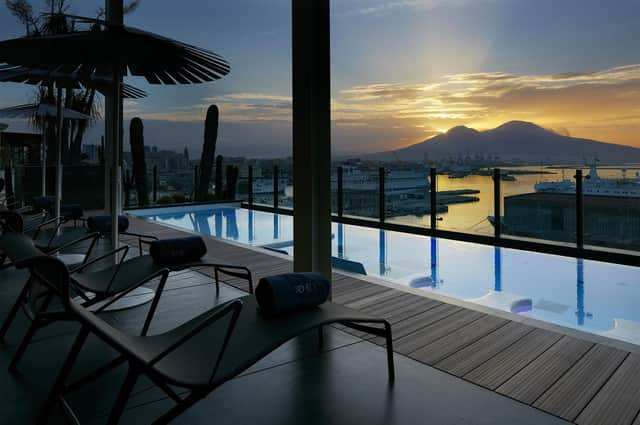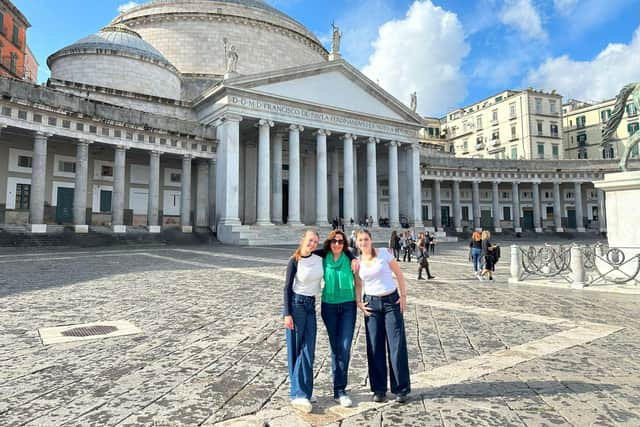Why Naples is so much more than just a transit city


Naples is the most undiscovered city in Europe and also the coolest, according to our Gennaro, a born and bred Neapolitan and guide extraordinaire. “People ignored it for years, regarding it as merely a transit city, and headed straight to the Amalfi coast.”
I have to admit, I was one of those people, flying into Naples, jumping into a hire car and making a beeline for Positano. Yet after a recent weekend visit to Italy’s third largest city, I discovered that Naples, is often misunderstood and stereotyped, and it actually makes for a really brilliant family weekend city break.
Advertisement
Hide AdAdvertisement
Hide Ad“Stanley Tucci and travellers looking for interesting places to visit post-Covid have put Naples back on the map. It’s also the youngest city in Italy by age of resident so it’s full of energy and life,” explained Gennaro.


Our base for the weekend was ROMEO Napoli (www.theromeocollection.com) and, according to Gennaro, the best hotel in Naples. The contemporary five-star hotel is located within the city centre’s Centro Storico, minutes walk away from the Castel Nuovo, the royal palace, and close to the hustle and bustle of Via Toledo and the Spanish Quarter. The hotel was originally a famous palazzo owned by Captain Achille Lauro, an Italian shipping magnet. Its current owner, Naples-born entrepreneur Alfred Romeo, transformed it into a luxury hotel in 2008, with the help of architect Kenzo Tange, resulting in a space which fuses Japanese architecture and influences with Italian design. On entering the hotel, guests feel like they are entering a design museum – albeit this one is friendly and accessible. More than 100 pieces of contemporary and fine art from Mr Romeo’s personal collection are displayed in both the communal areas and guest rooms and each piece on view is exceptional. The hotel has 79 rooms and 13 suites located across nine floors – guests can choose to have a room with views of Mount Vesuvius and the island of Capri or have a city view, looking onto the colourful rooftops of Naples and the medieval Castel Sant'Elmo.
A rooftop infinity swimming pool has views on to the Gulf of Naples, there is also 10,000 square feet La SPA Sisley Paris with saunas, Turkish bath and three pools, a well-stocked gym and an incredible lobby area with a water graphic fountain. As hotels go, this one has it all. For our first night, we decided to dine at Il Commandante, the hotel’s Michelin star restaurant, named in honour of its former owner. Its Executive Chef Salvatore Bianco grew up in the Torre del Greco area in Naples and his creative and mouth-watering menus take advantage of the best of the region’s produce. We opted for the tasting menu and feasted on fish, pasta, vegetable dishes – every course beautifully presented with some ingenious storytelling and food theatre thrown in. It was faultless and an incredible culinary start to the weekend. After a good night’s sleep we were ready to immerse ourselves in Naples’ history, art and culture. To do this, we booked a private tour called Highlights & Hidden Gems of Naples with With Locals (www.withlocals.com) and met our friendly and knowledgeable guide, Ylenia, for a three-hour tour. We learned all about the city’s history, significant castles, churches, palaces, and museums. We walked for 7km, mainly around the historic centre, visiting neighbourhoods such as Palloneotto with its laundry-laced narrow streets, seeing the real Naples and how locals live.
We visited the Plaza del Pleniscito, the largest square in Naples and home to many of the city’s most emblematic buildings, followed by Castell dell Ovo, the city’s oldest castle. Legend has it that it was named after the Roman scribe Virgil who reputedly buried an egg on the site where the castle now stands, warning that when the egg breaks, the castle (and Naples) will fall. Ylenia told us that even today local people still believe that the castle will never collapse while the egg is there.
Advertisement
Hide AdAdvertisement
Hide AdNext stop was Galleria Umberto, the iconic shopping gallery built between 1887 and 1890s after the unification of Italy, and arguably one of the city’s most beautiful buildings with its glass-roof and arching dome. The building is a UNESCO World Heritage site as a part of the historic city centre of Naples. Quartieri Spagnoli, Naples’ Spainish Quarter, was our final stop. This is the most densely populated part of the city - its tight grid of streets was laid out in the 1600s when the Spanish ruled the Kingdom of Naples and this was the district where the troops were quartered. For many years it was painted as a place to avoid, now tourists flock to its narrow, bustling streets which are packed with shops, restaurants and bars. Here, we also came across a series of murals that tell the history of Naples – and its most famous is dedicated to Diego Armando Maradona, painted on the side of a building three stories high by Napoli fan Mario Filardi. Street art is big in Naples – even Banksy has made his mark in the food district with his Madonna con la Pistola which is now, somewhat ironically, under protection after being covered in graffiti. “Eighty per cent of Naples is about food. If we are not eating food, we are talking or dreaming about it,” proclaimed Gennaro, our guide for our second tour, The 10 tastings of Naples, which (www.viator.com) As well as creating bespoke food experiences, Gennaro is a professional pizza maker, sous chef and sommelier. Our three-hour walking tour was really fun (the teens in our party really enjoyed it) and involved tasting local foods and drinks including Tarrallo – a type of savoury bagel, buffalo mozzarella, pizza Napoli style, with drinks along the way including a sparkling red prosecco from Gragnano, Limoncello, Meloncella and espresso.
People in Naples really know how to live. The city is alive, its energy is infectious, food scene incredible. Now is definitely the time to go. Bypass at your peril.